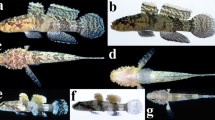Abstract
Analyses of the defensive secretions of 17 species of polydesmoid millipedes show that other chemicals besides HCN and benzaldehyde are liberated during cyanogenesis. Several members of the families Polydesmidae, Paradoxosomatidae, and Euryuridae are shown to secrete both phenol and guaiacol, with one paradoxosomatid also producing ethyl benzoate and benzoic acid. Also, members of the family Xystodesmidae commonly produce the three following compounds: benozoic acid, mandelonitrile benzoate, and benzoyl cyanide. Benzoyl cyanide has not been found previously as a natural product. The defensive role of these additional natural products as antipredator and antibiotic agents is discussed. For certain predators benzoyl cyanide in particular seems to possess anaesthetic properties. Our studies provide an initial chemotaxonomic basis for distinguishing between various polydesmoid taxa.
Similar content being viewed by others
References
Barbetta, M., Casnati, G., andPavan, M. 1966. The presence of D(+)-mandelonitrile in the defensive secretion of the myriapodeGomphodesmus pavani.Mem. Soc. Entomol. Ital. 45:169–176.
Blum, M.S. 1974. Deciphering the communicative Rosetta Stone.Bull. Entomol. Soc. Am. 20:30–35.
Blum, M.S., andWoodring, J.P. 1962. Secretion of benzaldehyde and hydrogen cyanide by the millipedePachydesmus crassicatus. Science 138:512–513.
Blum, M.S., Macconnell, J.G., Brand, J.M., Duffield, R.M., andFales, H.M. 1973. Phenol and benzaldehyde in the defensive secretion of a strongylosomid millipede.Ann. Entomol. Soc. Am. 66:235.
Booth, J., andBoyland, E. 1958. Metabolism of polycyclic compounds 13. Enzymic hydroxylation of naphthalene by rat-liver microsomes.Biochem. J. 70:681–688.
Casnati, G., Nencini, G., Quilico, A., Pavan, M., Ricca, A., andSalvatori, T. 1963. The secretion of the myriapod,Polydesmus collaris collaris. Experientia 19:409–411.
Cloudsley-Thompson, J.L. 1968. Millipedes, Chapter 2,in Spiders, Scorpions, Centipedes and Mites, J. L. Cloudsley-Thompson (ed.), Pergamon Press, Oxford.
Davenport, D., Wootton, D.M., andCushing, J.E. 1952. The biology of the Sierra luminous millipede.Luminodesmus sequoiae Loomis and Davenport.Biol. Bull. 102:100–110.
Dornow, A., andTheidel, H. 1954. Uber Acylierungen mit α-Ketonitrilen.Angew. Chem. 66:605.
Duffey, S.S., Underhill, E.W., andTowers, G.H.M. 1974. Intermediates in the biosynthesis of HCN and benzaldehyde by a polydesmid millipede,Harpaphe haydeniana (Wood).Comp. Biochem. Physiol. 47B:753–766.
Duffield, R.M., Blum, M.S., andBrand, J.M. 1974. Guaiacol in the defensive secretions of polydesmid millipedes.Ann. Entomol. Soc. Am. 67:821–822.
Eisner, H.E., Eisner, T., andHurst, J.J. 1963a. Hydrogen cyanide and benzaldehyde produced by millipedes.Chem. Ind. 1963:124–125.
Eisner, H.E., Wood, W.F., andEisner, T. 1975. Hydrogen cyanide production in North American and African polydesmoid millipeds.Psyche 82:20–23.
Eisner, T. 1970. Arthropod defenses, Chapter 8,in Chemical Ecology, E. Sondheimer and J.B. Simeone (eds.), Academic Press, New York.
Eisner, T., Eisner, H.E., Hurst, J.J., Kafatos, F.C., andMeinwald, J. 1963b. Cyanogenic glandular apparatus of a millipede.Science 139:1218–1220.
Guldensteeden-Egeling, C. 1882. Uber Bildung von Cyanwasserstoffsäure bei einem Myriapoden.Arch. Ges. Physiol. 28:576–577.
Huffman, R.L. 1976. Personal communication.
Holm, T. 1965. Thermal rearrangement of esters of cyanohydrins of α,β-unsaturated aldehydes.Acta Chem. Scand. 19:242–245.
Monteiro, H.J. 1961. Constituents of the secretion ofOrthomorpha coarctata Schubert.Anais Assoc. Brasil Quim. 20:29–31.
Pallares, E.S. 1946. Note on the poison produced by thePolydesmus (fontaria) vicinus Lin-Arch.Biochem. 9:105–108.
Rivers, J.J. 1886. Contributions to the larval history of Pacific coast Coleoptera.Bull. Calif. Acad. Sci. 2:64–72.
Roth, L.M., andEisner, T. 1962. Chemical defenses of arthropods.Annu. Rev. Entomol. 7:107–136.
Tiemann, D.L. 1967. Observations on the natural history of the western banded glowwormZarhipis integripennis (Le Conte) (Coleoptera: Phengodidae).Proc. Calif. Acad. Sci. 35:235–264.
Towers, G.H.N., Duffey, S.S., andSiegel, S.M. 1972. Defensive secretion: Biosynthesis of hydrogen cyanide and benzaldehyde from phenylalanine by a millipede.Can. J. Zool. 50:1047–1050.
Weatherston, J., andPercy, J.E. 1970. Arthropod defensive secretions,in Chemicals Controlling Insect Behavior, M. Beroza (ed.), Academic Press, New York.
Author information
Authors and Affiliations
Rights and permissions
About this article
Cite this article
Duffey, S.S., Blum, M.S., Fales, H.M. et al. Benzoyl cyanide and mandelonitrile benzoate in the defensive secretions of millipedes. J Chem Ecol 3, 101–113 (1977). https://doi.org/10.1007/BF00988137
Received:
Revised:
Issue Date:
DOI: https://doi.org/10.1007/BF00988137




